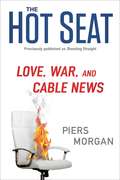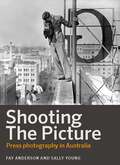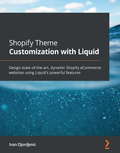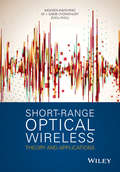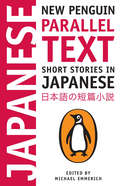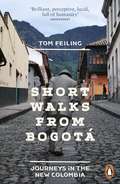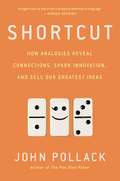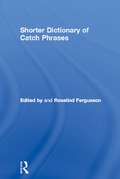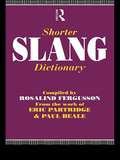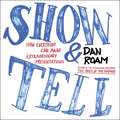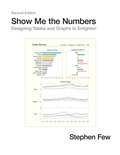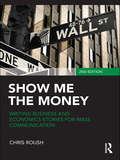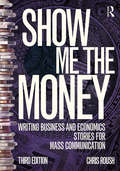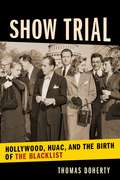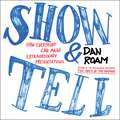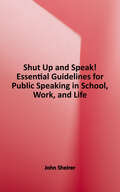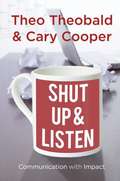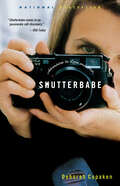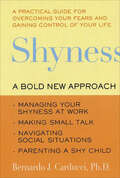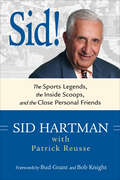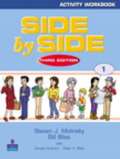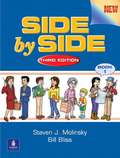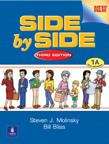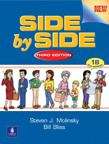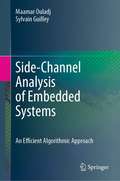- Table View
- List View
Shooting Straight: Guns, Gays, God, and George Clooney
by Piers MorganAs host of the CNN show "Piers Morgan Live," Piers Morgan has come a long way from his days as a British tabloid editor and judge on "America's Got Talent." Love him or hate him, it's undeniable that Morgan is one of the most talked-about, controversial figures in the media today. From gun control and gay marriage to religion and pop icons, he tackles the hot-button topics head on. In "Shooting Straight," he discusses candidly his refusal to bend to public pressure or political correctness, from his childhood in England to his career as a tabloid editor to his meteoric rise to fame in the United States. Offering an inside view of the real-time drama behind covering huge breaking news stories such as the killing of Osama bin Laden, Hurricane Sandy, and the massacre at Newtown, Morgan's account is a riveting, no-holds-barred depiction of an adrenaline-fueled life anchoring a nightly news show in the world's most ruthless, competitive, and pressurized media marketplace. Written in a compelling diary format, "Shooting Straight" provides a heartfelt account of Morgan's extraordinary new life and his continuing love affair with America. Shocking, funny, and incisive, it proves once again why Piers Morgan has taken the world by storm.
Shooting the Picture: Press photography in Australia
by Sally Young Fay AndersonShooting The Picture is the story of Australian press photography from 1888 to today—the power of the medium, seismic changes in the newspaper industry, and photographers who were often more colourful than their subjects. This groundbreaking book explores our political leaders and campaigns, crime, war and censorship, international events, disasters and trauma, sport, celebrity, gender, race and migration. It maps the technological evolution in the industry from the dark room to digital, from picturegram machines to iPhones, and from the death knock to the ascendancy of social media. It raises the question whether these changes will spell the end of traditional press photography as we know it.
Shopify Theme Customization with Liquid: Design state-of-the-art, dynamic Shopify eCommerce websites using Liquid's powerful features
by Ivan DjordjevicDiscover how to customize Shopify themes for your eCommerce websites with powerful tools and Liquid templatesKey FeaturesGet to grips with the Liquid core to build a solid foundation for working on any Shopify themeUse JSON to create Shopify's famous modular sections with powerful and complex functionalitiesUtilize the Shopify Ajax API to implement advanced functionality and make your eCommerce stores more dynamicBook DescriptionShopify is one of the fastest-growing eCommerce platforms, which means developers familiar with the Liquid concept are needed now more than ever. This book will help you to build a solid foundation by enabling you to develop your skills from the ground up by gaining essential theoretical knowledge of Liquid and putting that knowledge to use through hands-on projects.Shopify Theme Customization with Liquid begins by helping you get to grips with basic Shopify information, its interface and theme structure, setting up your Partner account, and creating a child theme, which is essential when preparing for any future work on Shopify. You'll then explore Liquid core features that will provide you with a basic understanding of the Liquid programming logic needed to develop any feature. As you advance to the latest and advanced features, you'll learn about JSON settings, allowing you to create any type of static or dynamic section - a must-have for becoming a competent Shopify developer. Finally, the book takes you through the Shopify Ajax API to gain the necessary skills needed to create a variety of dynamic features and content.By the end of this Shopify book, you'll be able to take on challenging projects to showcase your theme customization expertise to your future employer.What you will learnDiscover how to use logic and data comparison operators for various types of data within LiquidUse Liquid core features such as objects, tags, and filtersFind out how to customize themes using JSON settingsUse metafield objects to generate unique content on any pageUnderstand how to output the local or external media contentUse Shopify's famous drag-and-drop feature to rearrange sections on a storefrontTake Shopify's dynamic functionality to a whole new level using REST API endpointsWho this book is forThis book is for beginners and experienced CMS developers who want to learn about working with Shopify themes and customizing those themes using Liquid. Web developers designing professional e-commerce websites will also find this book useful. Besides familiarity with standard web technologies (HTML, CSS, and JavaScript), this book requires no prior knowledge of Shopify or Liquid. The book covers everything from Shopify fundamentals and the core of the Liquid and REST APIs, all the way through to the latest Liquid features that may be new to even proficient developers.
Short Range Optical Wireless
by Mohsen Kavehrad M. I. Chowdhury Zhou ZhouThis book discusses the fundamental aspects of multiple-source Optical Wireless Applications, including Visible Light Communications (VLC). Moreover, the authors explore VLC performance in several conventional household layouts and investigate the impact of these layouts on VLC. Multiple sources increase multipath distortion. Multi-input- Multi-Output (MIMO) techniques will be included as they provide either reliability improvement or bandwidth efficiency increase. Based on these topics, the book further explores VLC performance in real applications, such as aircraft cabin wireless communications. In addition, the authors describe the Lambertian emitting pattern of LEDs and the diffused features in indoor environments. Based on the theory, they trace light pulses to establish a MIMO indoor wireless channel model on specific sources layout. Next, they generate test data to simulate BER distribution in a room and calculate the outage. Furthermore, addresses the performance improvement when MIMO techniques are applied. Lastly, the authors investigate VLC performance in specific applications, including for aircraft on-board wireless communications. Finally, the pitfalls of MIMO systems are discussed.
Short Stories in Japanese: New Penguin Parallel Text (Penguin Parallel Text)
by Edited by Michael EmmerichA dual-language edition of Japanese stories—many appearing in English for the first time This volume of eight short stories, with parallel translations, offers students at all levels the opportunity to enjoy a wide range of contemporary literature without having constantly to refer back to a dictionary. The stories—many of which appear here in English for the first time—are by well-known writers like Haruki Murakami and Banana Yoshimoto, as well as emerging voices like Abe Kazushige, Ishii Shinji, and Kawakami Hiromi. From the orthodox to the cutting-edge, they represent a range of styles and themes, showcasing the diversity of Japanese fiction over the past few decades in a collection that is equally rewarding for beginning, intermediate, and advanced students of English or Japanese. Complete with notes, the stories make excellent reading in either language.
Short Walks from Bogotá: Journeys in the new Colombia
by Tom FeilingFor decades, Colombia was the 'narcostate'. Now travel to Colombia and South America is on the rise, and it's seen as one of the rising stars of the global economy. Where does the truth lie? Writer and journalist Tom Feiling, author of the acclaimed study of cocaine The Candy Machine, has journeyed throughout Colombia, down roads that were until recently too dangerous to travel, to paint a fresh picture of one of the world's most notorious and least-understood countries. He talks to former guerrilla fighters and their ex-captives; women whose sons were 'disappeared' by paramilitaries; the nomadic tribe who once thought they were the only people on earth and now charge $10 for a photo; the Japanese 'emerald cowboy' who made a fortune from mining; and revels in the stories that countless ordinary Colombians tell. How did a land likened to paradise by the first conquistadores become a byword for hell on earth? Why is one of the world's most unequal nations also one of its happiest? How is it rebuilding itself after decades of violence, and how successful has the process been so far? Vital, shocking, often funny and never simplistic, Short Walks from Bogota unpicks the tangled fabric of Colombia, to create a stunning work of reportage, history and travel writing.
Shortcut
by John PollackA presidential speechwriter for Bill Clinton explores the hidden power of analogy to fuel thought, connect ideas, spark innovation, and shape outcomes From the meatpacking plants that inspired Henry Ford's first moving assembly line to the "domino theory" that led America into Vietnam to the "bicycle for the mind" that Steve Jobs envisioned as the Macintosh computer, analogies have played a dynamic role in shaping the world around us--and still do today. Analogies are far more complex than their SAT stereotype and lie at the very core of human cognition and creativity. Once we become aware of this, we start seeing them everywhere--in ads, apps, political debates, legal arguments, logos, and euphemisms, to name just a few. At their very best, analogies inspire new ways of thinking, enable invention, and motivate people to action. Unfortunately, not every analogy that rings true is true. That's why, at their worst, analogies can deceive, manipulate, or mislead us into disaster. The challenge? Spotting the difference before it's too late. Rich with engaging stories, surprising examples, and a practical method to evaluate the truth or effectiveness of any analogy, Shortcut will improve critical thinking, enhance creativity, and offer readers a fresh approach to resolving some of today's most intractable challenges.
Shorter Dictionary of Catch Phrases: From The Work Of Eric Partridge And Paul Beale
by Rosalind FergussonThis collection will appeal to everyone who has ever wondered about the origin of phrases like "all part of life's rich pattern" and "long time no see". It covers a wide range of catch phrases in current use in all parts of the English-speaking world. Most entries are drawn from the second edition of Eric Partridge's Dictionary of Catch Phrases (second edition, edited by Paul Beale), but have been completely rewritten in the light of recent research, and there are many additions. Catch Phrases include: close your eyes and think of England! have I got news for you! ... refreshes the parts that other ... cannot reach some mothers do'ave'em! you are awful, but I like you.
Shorter Slang Dictionary
by Eric Partridge Paul BealeFrom abdabs to zit From pillock (14th century) to couch potato (20th century) From She'll be apples (Australia) to the pits (USA) This new collection brings together some 5,000 contemporary slang expressions originating in all parts of the English-speaking world. It gives clear and concise definitions of each word, supplemented by examples of their use and information about where and when they came into being. This entertaining reference work will be of use to students of English at all levels and a source of fascination to word-lovers throughout the world.
Show And Tell: How Everybody Can Make Extraordinary Presentations
by Dan RoamEven if you're already a good speaker, you'll learn more about understanding your audience, organizing your content, building a clear story line, creating effective visuals, and channeling your fear into fun. And you'll master three fundamental rules: #1; When we tell the truth, we connect with our audience, we become passionate, and we find self-confidence. #2; When we tell a story, we make complex concepts clear, we make ideas unforgettable, and we include everyone. #3; When we use pictures, people see exactly what we mean, we captivate our audience's mind, and we banish boredom. From nailing the opening to leaving a lasting impression, you'll soon be able to give the performance of a lifetime--time after time.
Show Me The Numbers: Designing Tables And Graphs To Enlighten
by Stephen FewAddressing the prevalent issue of poorly designed quantitative information presentations, this accessible, practical, and comprehensive guide teaches how to properly create tables and graphs for effective and efficient communication. The critical numbers that measure the health, identify the opportunities, and forecast the future of organizations are often misrepresented because few people are trained to design accurate, informative materials, but this manual helps put an end to misinformation. This revised edition of the highly successful book includes updated figures and 91 additional pages of content, including new chapters about quantitative narrative and current misuses of graphs--such as donut, circle, unit, and funnel charts--and new appendices that cover constructing table lens displays and box plots in Excel and useful color palettes for presentation materials.
Show Me the Money: Writing Business and Economics Stories for Mass Communication
by Chris RoushShow Me the Money is the definitive business journalism textbook that offers hands-on advice and examples on doing the job of a business journalist. Author Chris Roush draws on his experience as a business journalist and educator to explain how to cover businesses, industries and the economy, as well as where to find sources of information for stories. He demonstrates clearly how reporters take financial information and turn it into relevant facts that explain a topic to readers. This definitive business journalism text: provides real-world examples of business articles presents complex topics in a form easy to read and understand offers examples of where to find news stories in SEC filings gives comprehensive explanations and reviews of corporate financial, balance sheet, and cash flow statements provides tips on finding sources, such as corporate investors and hard-to-find corporate documents gives a comprehensive listing of websites for business journalists to use. Key updates for the second edition include: tips from professional business journalists provided throughout the text new chapters on personal finance reporting and covering specific business beats expanded coverage of real estate reporting updates throughout to reflect significant changes in SEC, finance, and economics industries. With numerous examples of documents and stories in the text, Show Me the Money is an essential guide for students and practitioners doing business journalism.
Show Me the Money: Writing Business and Economics Stories for Mass Communication (Routledge Communication Series)
by Chris RoushShow Me the Money is the definitive business journalism textbook that offers hands-on advice and insights into the job of a business journalist. Chris Roush draws on his experience as both a business journalist and educator to explain how to cover businesses, industry and the economy, as well as where to find sources of information for stories and how to take financial information and make it work for a story. Updates to the third edition include: Inclusion of timely issues related to real estate; Additional examples from websites and other nontraditional business media such as BuzzFeed and Quartz; Tips from professional business journalists including Andrew Ross Sorkin of The New York Times and Jennifer Forsyth of The Wall Street Journal. Essential for both undergraduate and graduate courses in business journalism and professional business journalism newsrooms, Show Me the Money is a must-read for reporters, editors and students who want to learn the ins and outs of how to cover public and private companies. Additional materieals, including a sample syllabus and additional links and tips for students can be found at https://www.routledge.com/products/9781138188389
Show Trial: Hollywood, HUAC, and the Birth of the Blacklist (Film and Culture Series)
by Thomas DohertyIn 1947, the Cold War came to Hollywood. Over nine tumultuous days in October, the House Un-American Activities Committee held a notorious round of hearings into alleged Communist subversion in the movie industry. The blowback was profound: the major studios pledged to never again employ a known Communist or unrepentant fellow traveler. The declaration marked the onset of the blacklist era, a time when political allegiances, real or suspected, determined employment opportunities in the entertainment industry. Hundreds of artists were shown the door—or had it shut in their faces.In Show Trial, Thomas Doherty takes us behind the scenes at the first full-on media-political spectacle of the postwar era. He details the theatrical elements of a proceeding that bridged the realms of entertainment and politics, a courtroom drama starring glamorous actors, colorful moguls, on-the-make congressmen, high-priced lawyers, single-minded investigators, and recalcitrant screenwriters, all recorded by newsreel cameras and broadcast over radio. Doherty tells the story of the Hollywood Ten and the other witnesses, friendly and unfriendly, who testified, and chronicles the implementation of the postwar blacklist. Show Trial is a rich, character-driven inquiry into how the HUAC hearings ignited the anti-Communist crackdown in Hollywood, providing a gripping cultural history of one of the most transformative events of the postwar era.
Show and Tell: How Everybody Can Make Extraordinary Presentations
by Dan Roam“If I tell you the truth, if I tell it with a story, and if I tell that story with pictures, I can keep you glued to your seat. Let me show you how.”For the vast majority of us, giving a presentation is an extremely difficult and nerve-wracking process, whether we’re in a one-on-one meeting, a conference room with a dozen strangers, or a lecture hall in front of thousands.But according to Dan Roam, the visual communications expert and acclaimed author of The Back of the Napkin, it doesn’t have to be so hard. We struggle when we forget the basic steps we learned in kindergarten: show and tell.In this short but powerful book, Roam introduces a new set of tools for making extraordinary presentations in any setting. He also draws on ideas he’s been honing for more than two decades, as an award-winning presenter who has brought his whiteboard everywhere from Fortune 500 companies to tiny startups to the White House.Even if you’re already a good speaker, you’ll learn more about understanding your audience, organizing your content, building a clear storyline, creating effective visuals, and channeling your fear into fun. And you’ll master three fundamental rules:• When we tell the truth, we connect with our audience, we become passionate, and we find self-confidence.• When we tell a story, we make complex concepts clear, we make ideas unforgettable, and we include everyone.• When we use pictures, people see exactly what we mean, we captivate our audience’s mind, and we banish boredom.From nailing the opening to leaving a lasting impression, you’ll soon be able to give the performance of a lifetime . . . time after time.PLEASE NOTE: This eBook edition of SHOW AND TELL is carefully laid out to match the print book; this means it reads much better as designed pages, but you won't be able to use some features such as highlighting and annotating text.
Shut Up and Speak!: Essential Guidelines for Public Speaking in School, Work, and Life
by John SheirerWhy does your mouth suddenly go dry, your throat tighten, your face gets hot, and your knees buckle when you have to address a group of people? The old story goes that more people are afraid of public speaking than they are of death. So people at a funeral would prefer to be the person in the casket than the person delivering the eulogy! Shut up and speak means that you must stop dwelling on how difficult or frightening public speaking is. Shut up and speak means that you can't become a better public speaker simply by studying communications theory or relying on public speaking folk wisdom. This book gives you the guidance to "shut up" by tuning out all of the interference that doesn't help you become a better public speaker and to "speak" by throwing yourself wholeheartedly into speech-making.
Shut up and Listen
by Theo Theobald Cary CooperMake sense of the communications explosion and increase your effectiveness in the workplace. Shut Up and Listen combines no-nonsense advice with insight into the latest tools from some leading opinion-formers. Master the art of the compelling message and discover how to apply it across the spectrum of communications channels. This revised and updated edition is packed with tipsfrom experts in leading global companies like Saatchi & Saatchi, Nokia, BBC and Microsoft. There are opportunities to test your own abilities and build your skills through a series of practical applications.
Shutterbabe: Adventures in Love and War
by Deborah Copaken KoganFrom Afghanistan to Zimbabwe to Romania to Haiti, Kogan takes her readers on a heartbreaking yet surprisingly hilarious journey through a mine-strewn decade, seamlessly blending her personal battles with the historical ones it was her job to record. Copyright © Libri GmbH. All rights reserved.
Shyness: A Bold New Approach
by Bernardo J. CarducciA &“hopeful, inspiring book that helps shy people to overcome self-defeating behaviors . . . and lead lives filled with greater intimacy and self-acceptance" (John Gray, author of Men Are From Mars, Women Are From Venus). In Shyness, Bernardo J. Carducci, PhD, draws on more than twenty years of research to penetrate the many myths and mysteries surrounding shyness. Through compelling case studies and numerous self-help strategies and self-assessment quizzes, he offers both inspiration and practical tools for shy people who seek greater self-awareness, self-acceptance, and self-confidence—in order to achieve what Dr. Carducci calls &“the successfully shy life.&” Dr. Carducci provides easy-to-implement strategies for: Managing your shyness when meeting new people Managing your shyness at work Making small talk Initiating romantic relationships Parenting shy children And more
Sid!: The Sports Legends, the Inside Scoops, and the Close Personal Friends
by Patrick Reusse Sid HartmanIn this memoir, the Dean of Twin Cities sports journalism looks back on his memorable career and the stories he has covered.Sid Hartman has been at the center of Minnesota sports for more than sixty years, getting the inside scoop from players, coaches, owners, and his many “close personal friends.” This fascinating tell-all reveals Sid’s life and career, from his days as a newspaper boy in Minneapolis and his first scoops as a cub reporter with the Minneapolis Tribune, to his place as a true Minnesota legend. From his controversial role as de facto general manager of the Minneapolis Lakers to his fight to save the Twins, Sid has been in the thick of the local sports scene at all levels.In these pages, sports fans will be privy to Sid’s insight into hundreds of events and legendary figures, from Bud Grant and Bob Knight to Kirby Puckett and Kevin Garnett. As one of the most widely read and listened-to sports journalists in the Midwest for over half a century, Sid’s impact has been felt by fans from all walks of life, including renowned figures such as Tom Brokaw and Walter Mondale, who called Sid “one of America’s hardest-working, most widely read sportswriters.”Join Sid and his cast of thousands, and enjoy their outrageous stories—and learn some Minnesota sports history in the process. This updated edition includes Sid’s reminiscences on the past decade of Minnesota sports, including the resurgent Twins, the rocky Vikings, and his always-beloved Gophers.
Side by Side Activity Workbook Book 1
by Steven J. Molinsky Bill Bliss Carolyn Graham Peter S. BlissThe Side by Side Activity Workbooks offer a variety of exercises for reinforcement, fully coordinated with the student texts.
Side by Side Book 1
by Steven J. Molinsky Bill BlissSide by Side, Third Edition, by Steven J. Molinsky and Bill Bliss, is a dynamic, all-skills program that integrates conversation practice, reading, writing, and listening -- all in a light-hearted, fun, and easy-to-use format that has been embraced by students and teachers worldwide. This four-level program promotes native communication between students ... practicing speaking together "side by side."
Side by Side Book 1A
by Steven J. Molinsky Bill BlissSide by Side, Third Edition, is the new and improved version of this dynamic, all skills program that integrates grammar and functions in a conversational approach all in a light-hearted, fun, and easy-to-use format that has been embraced by students and teachers worldwide.
Side by Side Book 1B
by Steven J. Molinsky Bill BlissSide by Side, Third Edition, is the new and improved version of this dynamic, all skills program that integrates grammar and functions in a conversational approach all in a light-hearted, fun, and easy-to-use format that has been embraced by students and teachers worldwide.
Side-Channel Analysis of Embedded Systems: An Efficient Algorithmic Approach
by Sylvain Guilley Maamar OuladjIt has been more than 20 years since the seminal publications on side-channel attacks. They aim at extracting secrets from embedded systems while they execute cryptographic algorithms, and they consist of two steps, measurement and analysis. This book tackles the analysis part, especially under situations where the targeted device is protected by random masking. The authors explain advances in the field and provide the reader with mathematical formalizations. They present all known analyses within the same notation framework, which allows the reader to rapidly understand and learn contrasting approaches. It will be useful as a graduate level introduction, also for self-study by researchers and professionals, and the examples are taken from real-world datasets.
